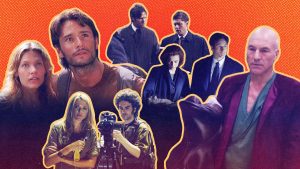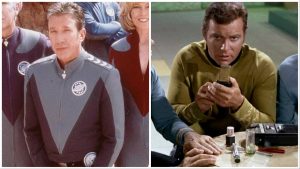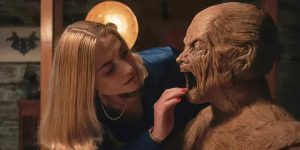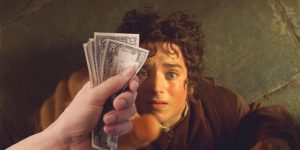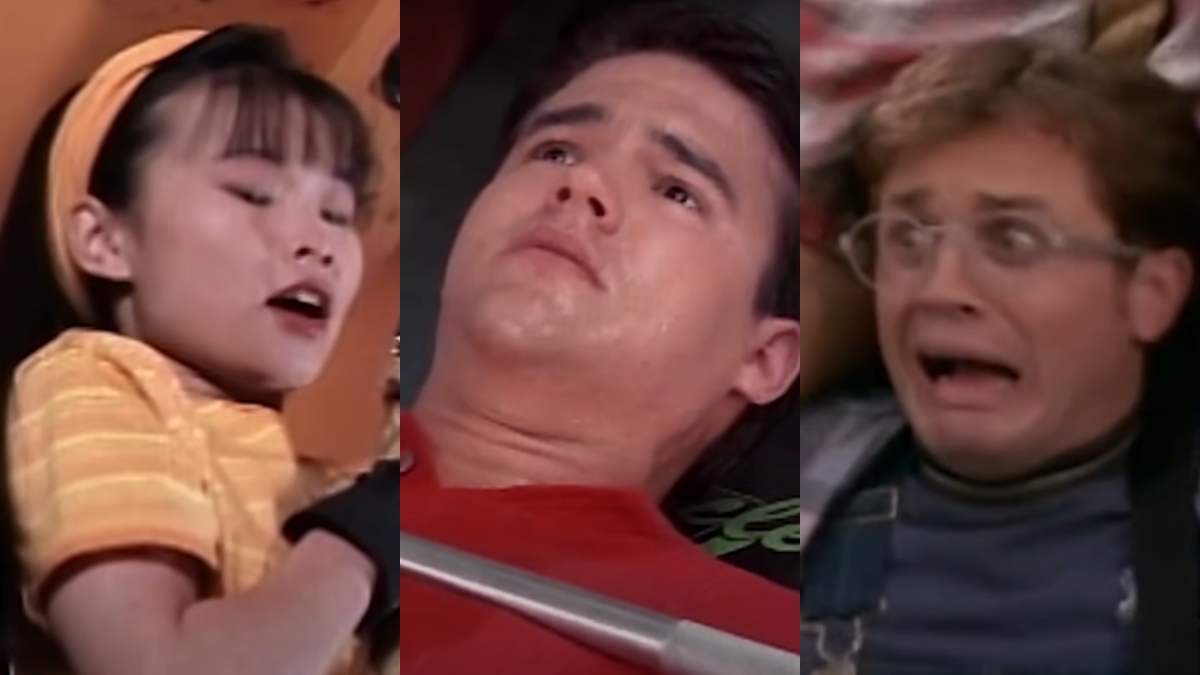
In our multimedia-filled landscape, long-running franchises dominate. Star Wars, Star Trek, Marvel, and many more started small without world conquering ambitions. Nowadays though, if every entry in your franchise doesn’t make more than the last one and you aren’t cracking a billion dollars at the box office? Your franchise is a colossal failure. Thus, each new entry in a franchise is handled with extreme oversight and planning, most of which consists of “how can we scientifically engineer this to make as much money as possible for our CEO?”
Power Rangers is in that same wheelhouse as a franchise with 30 seasons of television, three feature films, and endless spinoff material. Fans currently wait on baited breath for a new Netflix Power Rangers series that’s in the works. No doubt one of the reasons for the long process between the announcement of that series (back in 2020) and its ongoing development is the weight of the franchise. How do you make something that will please more than 30 years of collective memories and expectations? Can it capture the “spirit” of Power Rangers? How will it impact the brand long term and its profit potential?
Back in 1993, when the show first began production, the people working on it didn’t have time to consider such lofty questions. They were just trying to get this weird little mashup of Saved by the Bell antics and borrowed footage from a Japanese superhero series done as fast and cheaply as possible. Franchise potential was the last thing on the production crew’s minds. The first thing? Not horrifically injuring the cast.
“They could have cut their arms open!” Adrian Carr, director of four early episodes of Mighty Morphin Power Rangers’ first season, recalls as he discusses the lack of safety he observed in those early days. “We were doing fight scenes out at Vasquez Rocks (North of Los Angeles). When [the cast] tumbled in, those kids had no protection on their arms. I asked [the producers], can the cast wear long sleeved shirts? Or pants? Not shorts and t-shirts!”
Carr’s involvement with Power Rangers came shortly after the show was picked up to series by Fox Kids, helming the second production block which included what would become the show’s first episode. We sat down with Carr for an hours-long conversation after he uploaded his original cut of the first episode to YouTube. We had only intended to discuss his historic work on that episode, but Carr’s stories of stepping onto set and being greeted with a show teetering on the edge of meltdown demanded more investigation.
In the first episodes that went in front of the cameras, all five Rangers were in nearly every scene together. It didn’t matter if they were involved in that scene, they’d just be there, lines or no lines. This put a huge strain on the actors who spent five days a week constantly on set and their weekends in voice over sessions for dubbing the morphed Ranger action scenes that were taken from the Japanese Super Sentai series.
“They’d just fade,” Carr remembers. “Between takes they’d be sleeping.”
Power Rangers was not only an action heavy show, with major fight sequences featuring the American cast, but it was shot at lightning speed. For example, Carr explains that the four episodes he worked on were shot in a mere eleven days. Even a production with world class actors would struggle under that time limit and the Ranger actors were far from trained in acting.
“Amy Jo Johnson (Kimberly) and David Yost (Billy) had some formal training but [most of] the actors had no film experience. Austin St. John (Jason) had a great look but didn’t know what to do,” Carr says.
When observing the first block of episodes being shot, Carr noticed that St. John didn’t know what to do with himself on camera. Carr would take St. John, or any of the other actors who were struggling, aside and run scenes with them like a play. That way, when they’d get in front of the camera, Carr would be able to help the actors more easily recall the performance they needed to give for that particular shot.
The director’s involvement with the cast extended to more than just acting lessons, he even had to serve as a therapist of sorts when one of the cast was having emotional troubles. Carr doesn’t name who it was but does reveal, “they were having problems with their other half and they were distraught.”
Carr stopped production and took the actor to a quiet room where he talked them through the issue and calmed the situation. It baffled the crew why Carr was doing this when they were all just standing around waiting to film, but he knew that if he took that time it’d be better than just forcing the actor to keep going. The 15 minutes he spent calming the actor, in the long run, saved production time that would have been wasted on blown takes because of the actor’s emotional distress.
Even still, time was a major factor when directing Power Rangers. The show’s unique production difficulties, such as the elaborate suit for the robot side-character, Alpha 5, forced Carr to adjust the shooting schedule to keep the actor inside it safe. Breaks needed to be factored in because the actor would quickly get overheated and risk passing out.
Worrying about safety was a continual subject brought up by Carr. In the episode, “No Clowning Around,” Zack (Walter Emanuel Jones) not only walks on stilts but dances around on them. Carr puts his head in his hand in horror, recreating his reaction at the time.
“I thought… Zack, do not fall. I was petrified that, if he breaks his leg, what do we do?”
While no one would be injured during Carr’s time on the show, eventually an actor was injured on another show from the same producers of Power Rangers, VR Troopers. Brad Hawkins (Ryan Steele) suffered a massive injury during work on a live show that required a full ACL replacement. Production was able to continue but Hawkins required a double to perform in any shots that involved walking in or out of a scene for half a season. Not exactly what a brand new show struggling to get four episodes shot in eleven days would want to deal with.
The actors weren’t the only ones facing dangerous situations though, the crew experienced just as many hardships. While shooting the episode “High Five,” which involved the Rangers fighting in Vasquez Rocks, a treacherous location filled with unique rock formations, the script called for a rock to be in Billy’s path. Carr assumed the crew would just need to carry a lightweight foam rock out to the cliff location.
“I saw the props truck arrive. The flatbed came out and they wheeled this rock out and lowered it down. It was like two tons of rock and was just on a little base with wheels!”
Carr was stunned and refused to ask the crew to get that rock halfway up a cliff face. While taking a few minutes to talk out how they could find another way to shoot the scene, Carr turned around and saw the crew members already halfway up the cliff with the dangerously heavy rock.
“They didn’t want to let you down,” one of the crew explained to him. “They said they didn’t want to disappoint you because you said not to worry about it.”
Carr couldn’t do much about it at that point so let them proceed. One of the few times that he was held up in filming that didn’t involve mortal peril or the inexperience of the actors was because of Power Rangers co-creator Haim Saban. Carr was shooting on a set where, “you could hear everything in the room” and Saban was talking business on his phone. Carr called to roll sound and Saban kept talking. He called roll camera. Saban was still talking. Carr then announced,
“When I have quiet in the room, I’ll call action.”
Saban, a notorious businessman who once summed up his ethos of making children’s entertainment with, “make them cry, make them laugh, take their money,” shut up.
But only because money was being spent when the camera was rolling. Still, Carr laughs, “he never spoke on set again.”
Haim Saban often gets credit as the sole creator of Power Rangers but a key figure who never gets enough recognition or credit is Tony Oliver. While only credited as a supervising producer, Oliver had a huge input on the creation and development of the show along with working out how best to work with the Japanese action footage. He had a hand in all the early episodes.
“Tony was the heart and soul of Power Rangers. I was just doing one block. He’s doing the whole lot! He was dedicated to getting it done as best as it could be done in the time given. It was unbelievable. Poor Tony, his eyes were hanging out of his head.”
Oliver would apologize to Carr and others for the constant changes to the scripts, which were, at best, merely placeholders for what would actually make it to screen. The element most in flux was the dialogue dubbed over the Japanese footage, which Oliver would work on writing day and night. Carr barely even saw any of that Japanese footage while directing his episodes.
While there would be dialogue written for those scenes, which would connect to the American original story, it would often be completely reworked before it went to air. This necessitated the show creating ways to more easily work those last minute changes into the plot. One of the ways the show accomplished this was a distinctive aspect of the Rangers’ mentor, Zordon. A giant blue head floating in a tube, the character’s mouth is partially obscured, a choice that Carr says was down to Oliver and the writers knowing they could use that to change Zordon’s lines later in production.
“They kept Zordon’s mouth blurred so they could write anything for him and it would look in sync.”
With the scripts constantly changing, Carr’s main directive from the higher ups was simply, “get us good footage to work with and we’ll sort it out in post.”
A critical point, not just for Carr but Power Rangers in general, was a meeting during the production of “No Clowning Around.” All the heads of production, including Haim Saban, were there, and Saban stressed that, “there’s a lot riding on this episode.” This was going to be the episode that, according to Carr, would convince Fox Kids to pick up more episodes of the show past its initial order.
With this added pressure, Saban wanted more action in the episode to make it look better. Carr had previously been told to tone down any violence but Saban insisted that the enemies the human characters would fight, the Putties, weren’t human, so any amount of violence against them was okay. This explains why “No Clowning Around” features sequences like the Rangers fighting at a real carnival, with Kimberly striking Putties with the chains of a massive swing, Zack tricking a Putty into getting hit by a massive ride, and impressive punches and kicks from Jason.
Carr left the show after four episodes but remained in contact with Thuy Trang (Trini), who sadly passed away in 2001. Trang, still a beloved fan favorite, would regularly call Carr from the set. “[She’d say,] ‘I’m doing this scene, how do I approach this, this, and this.’ So I’d give her some pointers and she’d say ‘thank you’ and off she’d go.”
Looking back on his eleven days of work on the show over 30 years later, Carr gives all the credit he can to the amazing crew and cast, who he believes should have all been treated better. “There’s no residuals. What those [actors] went through was cruel.” Despite the hellish conditions of making the show, Carr explains how he was able to establish some order to the chaos of the early days of Power Rangers.
“You treat people with respect and kindness and authority at the same time. Like with the crew taking the rock up the hill. I could have thrown a hissy fit and demanded them to get it up there. But the fact that I said, ‘don’t, I’ll work around it somehow.’ The [crew] went above and beyond because I respected them. If you respect the people around you? You actually get better work out of them.”
In our modern world of franchises where endless amounts of “content” are pushed out and more concern is paid to a brand’s “image” than the well-being of the professionals working on it? The people working on any piece of media deserve respect, especially those who helped get it off the ground in the first place.
The post Power Rangers: Inside the Growing Pains of the Show’s Early Days appeared first on Den of Geek.
